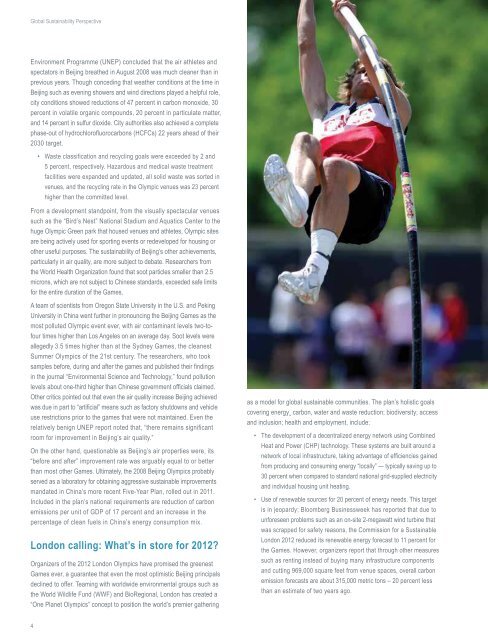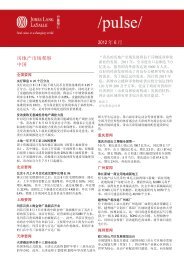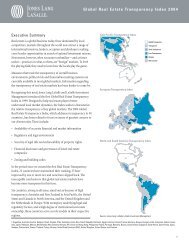Global Sustainability Perspective magazine - Jones Lang LaSalle
Global Sustainability Perspective magazine - Jones Lang LaSalle
Global Sustainability Perspective magazine - Jones Lang LaSalle
You also want an ePaper? Increase the reach of your titles
YUMPU automatically turns print PDFs into web optimized ePapers that Google loves.
<strong>Global</strong> <strong>Sustainability</strong> <strong>Perspective</strong><br />
Environment Programme (UNEP) concluded that the air athletes and<br />
spectators in Beijing breathed in August 2008 was much cleaner than in<br />
previous years. Though conceding that weather conditions at the time in<br />
Beijing such as evening showers and wind directions played a helpful role,<br />
city conditions showed reductions of 47 percent in carbon monoxide, 30<br />
percent in volatile organic compounds, 20 percent in particulate matter,<br />
and 14 percent in sulfur dioxide. City authorities also achieved a complete<br />
phase-out of hydrochlorofluorocarbons (HCFCs) 22 years ahead of their<br />
2030 target.<br />
• Waste classification and recycling goals were exceeded by 2 and<br />
5 percent, respectively. Hazardous and medical waste treatment<br />
facilities were expanded and updated, all solid waste was sorted in<br />
venues, and the recycling rate in the Olympic venues was 23 percent<br />
higher than the committed level.<br />
From a development standpoint, from the visually spectacular venues<br />
such as the “Bird’s Nest” National Stadium and Aquatics Center to the<br />
huge Olympic Green park that housed venues and athletes, Olympic sites<br />
are being actively used for sporting events or redeveloped for housing or<br />
other useful purposes. The sustainability of Beijing’s other achievements,<br />
particularly in air quality, are more subject to debate. Researchers from<br />
the World Health Organization found that soot particles smaller than 2.5<br />
microns, which are not subject to Chinese standards, exceeded safe limits<br />
for the entire duration of the Games.<br />
A team of scientists from Oregon State University in the U.S. and Peking<br />
University in China went further in pronouncing the Beijing Games as the<br />
most polluted Olympic event ever, with air contaminant levels two-tofour<br />
times higher than Los Angeles on an average day. Soot levels were<br />
allegedly 3.5 times higher than at the Sydney Games, the cleanest<br />
Summer Olympics of the 21st century. The researchers, who took<br />
samples before, during and after the games and published their findings<br />
in the journal “Environmental Science and Technology,” found pollution<br />
levels about one-third higher than Chinese government officials claimed.<br />
Other critics pointed out that even the air quality increase Beijing achieved<br />
was due in part to “artificial” means such as factory shutdowns and vehicle<br />
use restrictions prior to the games that were not maintained. Even the<br />
relatively benign UNEP report noted that, “there remains significant<br />
room for improvement in Beijing’s air quality.”<br />
On the other hand, questionable as Beijing’s air properties were, its<br />
“before and after” improvement rate was arguably equal to or better<br />
than most other Games. Ultimately, the 2008 Beijing Olympics probably<br />
served as a laboratory for obtaining aggressive sustainable improvements<br />
mandated in China’s more recent Five-Year Plan, rolled out in 2011.<br />
Included in the plan’s national requirements are reduction of carbon<br />
emissions per unit of GDP of 17 percent and an increase in the<br />
percentage of clean fuels in China’s energy consumption mix.<br />
London calling: What’s in store for 2012?<br />
Organizers of the 2012 London Olympics have promised the greenest<br />
Games ever, a guarantee that even the most optimistic Beijing principals<br />
declined to offer. Teaming with worldwide environmental groups such as<br />
the World Wildlife Fund (WWF) and BioRegional, London has created a<br />
“One Planet Olympics” concept to position the world’s premier gathering<br />
June 2012<br />
as a model for global sustainable communities. The plan’s holistic goals<br />
covering energy¸ carbon, water and waste reduction; biodiversity; access<br />
and inclusion; health and employment, include:<br />
• The development of a decentralized energy network using Combined<br />
Heat and Power (CHP) technology. These systems are built around a<br />
network of local infrastructure, taking advantage of efficiencies gained<br />
from producing and consuming energy “locally” — typically saving up to<br />
30 percent when compared to standard national grid-supplied electricity<br />
and individual housing unit heating.<br />
• Use of renewable sources for 20 percent of energy needs. This target<br />
is in jeopardy; Bloomberg Businessweek has reported that due to<br />
unforeseen problems such as an on-site 2-megawatt wind turbine that<br />
was scrapped for safety reasons, the Commission for a Sustainable<br />
London 2012 reduced its renewable energy forecast to 11 percent for<br />
the Games. However, organizers report that through other measures<br />
such as renting instead of buying many infrastructure components<br />
and cutting 969,000 square feet from venue spaces, overall carbon<br />
emission forecasts are about 315,000 metric tons – 20 percent less<br />
than an estimate of two years ago.<br />
One thing is clear:<br />
Regardless of who wins the individual events at<br />
London, Rio and beyond, it seems that the Olympic<br />
Games will permanently encourage a gold medal<br />
performance for sustainability.<br />
• Venues that are being designed to use 40 percent less water,<br />
and athlete housing 30 percent less, than standard. Much of the<br />
improvement will come from a dual system in new buildings with<br />
separate supplies of drinking and recycled water, to assure that<br />
potable water will be used only when necessary.<br />
• Instead of the frequent practice of landfilling contaminated soil – which<br />
only shifts the problem from one spot to another – Olympic authorities<br />
have chosen to clean up all contaminated soil on site, using five soil<br />
washing machines and a bioremediation plant that will clean 1.3<br />
million tons of soil by the time they are finished.<br />
• Reclamation and re-use/recycling of 90 percent of demolition waste<br />
by weight. To date, that goal has been exceeded with a remarkable<br />
98 percent demolition waste reclamation. In addition, 63 percent of<br />
new construction materials have been transported to Olympic Park<br />
by rail or water.<br />
• As part of a pledge to send zero waste to landfill during the Games,<br />
food packaging that cannot be re-used or recycled will be made from<br />
compostable materials such as starch and cellulose-based bioplastics.<br />
After use, many of these materials will be suitable for anaerobic<br />
digestion, enabling them to be converted into renewable energy.<br />
• Making the Olympic Park one of the most nature-friendly Gamesrelated<br />
venues ever, with 45 hectares of wildlife wetland habitat and<br />
675 bird nesting boxes, ensuring that otters, swans, bats and scores<br />
of other wildlife will occupy the same area as athletes and spectators.<br />
In addition, remediation of invasive Japanese knotweed has enabled<br />
more diverse native species to proliferate.<br />
Perhaps the most advanced green thinking applied to the London initiatives<br />
is the concept of not just adapting Olympic Park and sporting venues to post-<br />
Olympic use, but making their sustainable legacy the primary consideration<br />
in all design and planning. Flats built for about 17,000 athletes have been<br />
built specifically to be used after the Games, as are 12,000 additional new<br />
homes surrounding the Olympic Village in Stratford City, an East London<br />
development located close to the city centre on the site of a former railroad<br />
yard. A new legacy shopping centre in Stratford City designed for Olympic<br />
use and beyond is also exemplary in its design, making use of natural<br />
light, effective insulation, high efficiency lighting, heating and cooling, and<br />
control of solar gain to ensure that the buildings are at least 10 percent more<br />
energy efficient than local regulations require. The centre will use a<br />
250,000-square-foot rainwater system for toilet flushing.<br />
4 5<br />
<strong>Jones</strong> <strong>Lang</strong> <strong>LaSalle</strong><br />
In June 2012, <strong>Jones</strong> <strong>Lang</strong> <strong>LaSalle</strong> is also publishing a more in-depth white<br />
paper on the sustainability achievements of the London Olympics and its<br />
impact on the broader industry. When this white paper is published, it will<br />
be made available on the <strong>Global</strong> <strong>Sustainability</strong> <strong>Perspective</strong> website.<br />
Rio and the rainforest<br />
Like London, Rio de Janeiro ran on a strong environmental theme, “Green<br />
Games for a Blue Planet,” to help win hosting of the 2016 Summer Olympic<br />
Games. And as with Beijing, the host nation – in this case, Brazil – will use<br />
the Games to position itself as a first-tier global superpower with the seventhlargest<br />
gross domestic product.<br />
Environmentally, Rio already has some sustainable distinctions from<br />
other Olympic host cities. For one thing, according to the Major Events<br />
International information portal, a whopping 45 percent of Brazil’s energy<br />
already comes from renewable sources. The city’s goal is to power 100<br />
percent of its public transportation with clean biodiesel ethanol by the<br />
Games, and create a network of bike paths connecting all Olympic facilities.<br />
On the downside, according to the Rio 2016 <strong>Sustainability</strong> Management<br />
Plan, as of 2008, only 32 percent of the waste dumped into Rio’s bays<br />
was treated. Officials have set an ambitious goal of 80 percent treated<br />
sewage by the beginning of the Games in 2016. Like Los Angeles and<br />
Atlanta, Rio will “recycle” many existing facilities for key events, including<br />
the opening and closing ceremonies, track and field, football, aquatics,<br />
basketball, volleyball and gymnastics. And like post-millennial Games,<br />
much of the energy for new venues will come from renewable sources.<br />
One of the most dazzling components of the 2016 Rio Games should be its<br />
Olympic Village, a green paradise of flora and fauna meant to emulate the<br />
Amazon rainforest. It remains to be seen whether this verdant park will call<br />
to attention the plight of Brazil’s actual receding rainforest, much as media<br />
attention – and television cameras – in 2008 focused on the continual haze<br />
in Beijing. Some critics have already pointed out that regardless of what<br />
Brazil does at Olympic venues, its greatest sustainable legacy would be<br />
to reverse deforestation of the Amazon jungle, an act considered by many<br />
to affect global climate change. With the eyes of the world on Brazil, the<br />
nation’s leaders may consider strengthening their efforts to preserve<br />
one of the planet’s greatest natural resources.
















